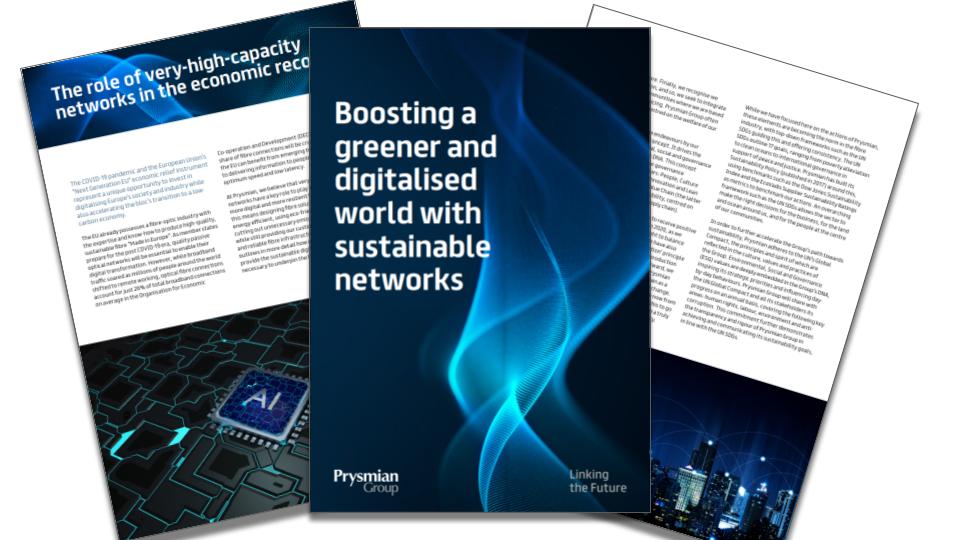Fibre-to-the-home network owners and operators are ramping up their efforts to enhance sustainability in their network infrastructures.
This shift is driven by multiple factors, such as the ever-rising demand for high-speed connectivity and the governmental targets to achieve them, the need to minimise environmental impact, and of course, to optimise operational efficiency and lower cost.
Fortunately for operators delivering full-fibre networks, fibre optic cables are widely documented to consume less energy-per-kilowatt than their copper counterparts. What’s more, the passive nature of the associated optical components in an FTTH network mean that electrical currents are not needed, and likewise, neither are the types of cooling systems associated with legacy copper networks. The manufacture of the cables themselves can also be less damaging to the environment than mining for copper.
The challenge for operators lies in the network deployment or upgrade, particularly in areas where legacy infrastructure such as ducting already exists, as any repeated digging and construction work on roads would not only be disruptive, but also an unsustainable practice.
Higher capacity using existing resources
One solution is to adopt densification, which involves packing as much capacity as possible into the existing resource. Ian Griffiths, Global Telecom R&D VP at Prysmian Group explains: “To reduce the cable diameter, there are a number of parameters that we can change, such as the fibre size. Standard optical fibre is 250µm in diameter, but large segments of the market are now moving to reduced diameter 200µm fibres, which Prysmian was the first to bring to the market back in 2009. Then more recently Prysmian was the first to launch a commercially available 180µm fibre in 2019.”
Smaller cables also provide sustainability benefits to the wider supply chain, as Griffiths explains: “Smaller cables, such as our Sirocco microduct cables use less raw materials, and therefore use less Co2 in the manufacturing process. Additionally, as more cable can be supplied on the drum there are less truck rolls required and better cutting efficiencies.” This can help reduce the environmental footprint for operators, as well as lowering those all-important costs.
Another parameter, says Griffiths, is the quality of the fibre. “Moving to bend insensitive fibre, for example,” he says, “allows the fibres to be packed tighter together within the cable, with less risk of macro or micro bend losses”.
Macro bends are visible to the naked eye, such as fibre cabling which bends around corners, fibre routing inside splicing closures and other connectivity devices. Macro bending is especially likely to occur within high-density networks, as space is limited. As fibre networks become more crowded, fibre bends are more likely to occur. Preventing power leakage with G.657 fibres therefore becomes crucial for optical systems with limited power budget. Bend resistance allows the use of smaller connectivity equipment such as loop guides and splice trays and in dynamic network environments, bend resistance extends the expected network lifetime by improving repair resilience too. Utilising wavelength division multiplexing (WDM) optics in PON and wireless networks drives the need for bend-insensitive fibres to become part of FTTX and 5G mobile networks.
Micro bends refer to microscopic local effects on a cable, and they are especially likely to occur within high-density cables, as fibres can touch each other due to their tight packing, material shrinkage or other strain effects. Micro bend resilience is extremely important for cables that will experience wide temperature variations, as these variations can induce material shrinkage. While bend-insensitive fibres were initially developed with macro bend insensitivity in mind, they also outperform all other existing fibre types for micro bend-insensitivity.
Bend-insensitive fibres for reliable connectivity
Bend-insensitive single mode fibres (ITU-T G.657.A1 and G.657.A2) are a crucial part of the world’s shift towards flexible and reliable connectivity. They are the only fibres capable of securing the whole fibre spectrum, especially at the longer wavelengths (1625nm and above). These fibres enable the development of extreme fibre count and reduced diameter cabling solutions, so we can meet today’s demand for the highest bandwidth capacity in duct installations. Not only will we see benefits through faster and more stable optical networks, installations will become more cost effective, more environmentally friendly, all with lower operational costs as network lifespan increases thanks to higher repair resilience. Bend-insensitive fibre’s resilience gives manufacturers the ability to design cabling solutions which were previously impossible to create, but are now demanded by today’s rapidly changing environments.
Such an example is Prysmian’s latest innovation, the Sirocco Extreme 864f cable. Prysmian has not rested on its laurels since the launch of its first 180µm fibre cable in 2019. The Sirocco Extreme 864f microduct cable, sets a new standard for innovation, thanks to its whopping 864 fibres within a 9.8mm diameter, providing a world record fibre density of 11.5 fibres per mm2. This makes it possible to install into a 12mm duct, allowing operators to push the boundaries of what they can achieve with their network efficiency. What’s more, the new cables employ the firm’s BendBrightXS 180µm single-mode (ITU-T G.657.D, G.657.A2) bend-insensitive fibre, ensuring compatibility with existing G.652 fibres and readiness for future systems.
Choose a supplier with green credentials that match your own
It’s not just the supply of products where Prysmian’s green credentials shine, operator customers can also benefit from efficiencies that the firm can pass on, thanks to its own environmental, social, and corporate governance (ESG) commitments. Prysmian has even recently been recognised in the Dow Jones Sustainability World Index (DJSI World), reaching excellence (100 points) in the environmental areas of Emissions, Resource Efficiency and Circularity, Waste, and Water, within the ELQ Electrical Components & Equipment sector.
As well as making the cables smaller in line with densification requirements, the company can also use recycled materials in its fibre optic cable manufacture. In fact, having committed to reaching a target of recycling 65% of its own waste materials by 2022, Prysmian exceeded this target in the same year, reaching 71%.
With facilities in more than 50 countries, including 112 plants, 25 research and development centres, and approximately 30,000 employees, Prysmian has an enviable global reach. But, importantly to network operator customers, this reach is combined with a local mindset. This not only means that operators can more sustainably source optical network technology from within their own geographical location, but also provides peace of mind that they can contact a member of the team in their own region if they have any queries or need any advice.



